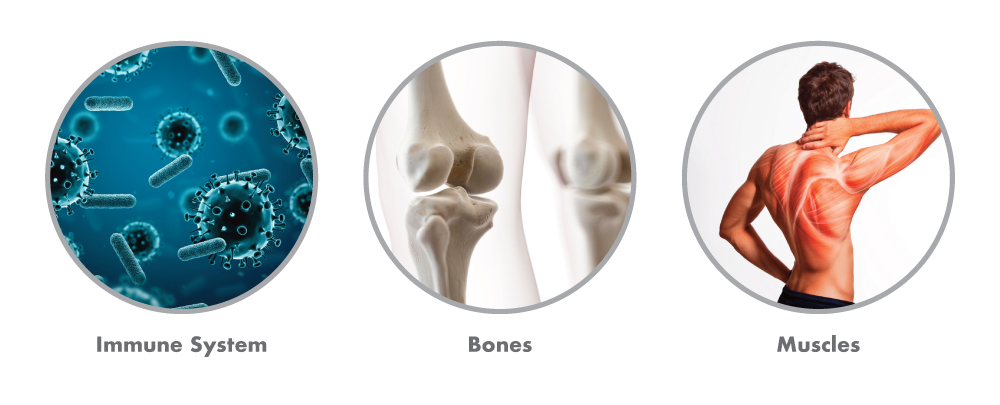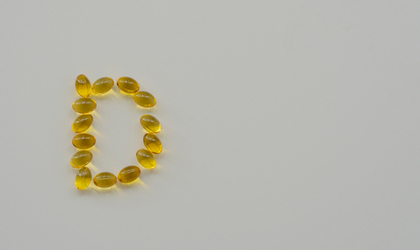Dubbed the ‘sunshine vitamin’ because the body manufactures it after sun exposure, vitamin D is indispensable for health. However, since the body synthesises vitamin D from sunlight, ensuring a regular intake isn’t always easy in the UK.
With 1 in 6 people in the UK with low vitamin D status, we’ve compiled a list of frequently asked questions, so you can easily find the answers you need about this essential nutrient.
WHY DO I NEED VITAMIN D?
Vitamin D contributes to:
-
Vitamin D contributes to normal absorption/utilisation of calcium and phosphorus
-
Vitamin D contributes to normal blood calcium levels
-
Vitamin D contributes to the maintenance of normal bones
-
Vitamin D contributes to the maintenance of normal muscle function
-
Vitamin D contributes to the maintenance of normal teeth
-
Vitamin D contributes to the normal function of the immune system
-
Vitamin D has a role in the process of cell division

HOW MUCH VITAMIN D3 SHOULD I TAKE?
The Government in the UK has issued public health advice stating that everyone should consider taking vitamin D supplements in Autumn and Winter. The dosage recommended is 10µg/micrograms (400iu) of vitamin D per day. However, many of our customers like to take a higher dose than this during this time and you can safely take up to 50µg/micrograms (2000iu) daily. All of our vitamin D3 products are safe to be taken on a daily basis at the doses recommended on the packaging. If you are still unsure on the right product to choose, please contact Nutrition Advice.
HOW LONG SHOULD I TAKE VITAMIN D FOR?
As with the majority of supplements, taking them consistently is the best way to notice a difference, and similarly, they don’t all present overnight change. Research shows, from the start of supplementation, that the greatest increase of vitamin D levels came between 3 to 9 months (ii). For every daily 100iu (2.5mcg) supplement of vitamin D, vitamin D levels, measured as serum 25(OH)D, are expected to rise by about 1 ng/mL (iii). Since we are all unique, the period of time it would take to change the dial on our vitamin D levels should be advised by a qualified nutritionist, or health care practitioner.
WHO’S AT RISK OF HAVING LOW VITAMIN D LEVELS?
Anyone can be deficient in vitamin D, and research suggests that 1 in 6 adults in the UK have low levels of vitamin D in their blood [1]. However, certain groups of people are at higher risk of vitamin D deficiency than others. These groups include:
-
Those who are housebound and/or get little to no sun exposure during the summer
-
Pregnant and breastfeeding women
-
People over the age of 65 years old
-
People who are significantly overweight
-
People with darker skin e.g. those of South Asian, Afro-Caribbean or African origin
In a study in 2021* researchers took advantage of a model developed to show how oral supplementation of different doses of vitamin D (cholicalciferol) influences functions in the body. One outcome showed a continuous daily intake of vitamin D at 2000iu helps to achieve and sustain vitamin D blood levels without crossing the 125nmol/L maximum blood level.
*Adapted from Huang and You 2021.
The graph below shows that vitamin D supplementation at a level of 2000iu:
-
Achieves and sustains adequate vitamin D blood levels
-
Without crossing the 125nmol/L maximum blood level

WHAT IS THE DIFFERENCE BETWEEN VITAMIN D2 AND D3?
Vitamin D is mainly found in two forms: vitamin D2 or ergocalciferol, and vitamin D3 or cholecalciferol. Vitamin D2 is mostly found in mushrooms and some fortified foods, however it is not as bioavailable as vitamin D3. Vitamin D3 is found in some fish and dairy products, and this is also the form that is produced by our bodies when we are exposed to sunlight. This form of vitamin D is widely agreed to be the superior form, so we use vitamin D3 in all of our products.
WHICH LEVEL IS RIGHT FOR ME?
Vitamin D3 1000iu (25µg/micrograms) - This level can be taken during the winter months but can be taken all year round, particularly if you do not spend much time in the sun in the spring and summer months. This is our most popular strength and the one we recommend most often.
Vitamin D3 2000iu (50µg/micrograms) - The maximum dose we recommend, often taken by those who are at higher risk of deficiency, those who are significantly overweight or have bone health concerns.
Vitamin D3400iu (10µg/micrograms)- The amount recommended by the Department of Health. This is the minimum that we would recommend daily, and is often taken by those also taking a multivitamin which contains vitamin D. This dose is what we recommend for children from age 3 and up.
WHAT DO ALL OF THE SYMBOLS AND MEASUREMENTS MEAN?
Vitamin D in food and supplements is generally measured in either international units (iu) or micrograms (µg). For vitamin D, each microgram is equivalent to 40iu. Therefore, the recommended level for vitamin D supplementation of 10µg is also equivalent to 400iu. You may find products on the market that use either one or the other, but we always provide both measurements so that our customers can easily find the level that they need.
Note: Micrograms is often also written as ‘mcg’, but this should not be confused with ‘mg’, which stands for milligrams. Vitamin D is only needed by the body in very small quantities, so should never be provided in milligrams.
CAN YOU GET VEGAN VITAMIN D3 SUPPLEMENTS?
Yes, you can. Our Vegan Vitamin D3 1000iu contains vitamin D extracted from lichen, so it is suitable for vegetarians and vegans. This source of vitamin D3 has exactly the same bioavailability as vitamin D3 from lanolin.
IS VITAMIN D WELL ABSORBED IN THE BODY?
Vitamin D3 is fat soluble, so the majority of our vitamin D products are dissolved in vegetable oil, to assist absorption. Vitamin D3 1000iu (25µg), Vegan Vitamin D3 1000iu (25µg) and Vitamin D3 2000iu (50µg) are dissolved in sunflower oil, and our D3 Drops are suspended in virgin olive oil. Our Vitamin D3 400iu (10µg) is in tablet form, so we recommend taking it with a meal, preferably one containing some fat.
WHAT FOODS CONTAIN VITAMIN D?
Vitamin D is found naturally in oily fish and dairy products, and in eggs in small quantities. Some foods may also be fortified with vitamin D, but most of us still obtain the majority of our vitamin D through exposure to sunlight in spring and summer.
CAN I GET TOO MUCH VITAMIN D?
The NHS advises not to take more than 100µg (4000iu) of vitamin D per day, as very high doses of vitamin D can cause negative side-effects. We tend to recommend no more than 50-75µg of vitamin D per day. Higher doses than this can be recommended by a doctor for certain people, but it is advisable to only take high doses of vitamin D if you are under the guidance of your GP or healthcare professional.
WHY ARE SOME SUPPLIERS SELLING MUCH HIGHER LEVELS AND ARE THEY SAFE?
There are company’s supplying extremely high levels of vitamin D, but these should be approached with extreme caution. As explained above ‘CAN I GET TOO MUCH VITAMIN D?’, exceeding the guideline intakes can cause health concerns. Sadly, some products in the market contain levels far exceeding what we would consider safe. For trusted advice, we recommend speaking with your health care professional, or following the NHS guidelines above.
DOES VITAMIN D INTEREACT WITH ANY MEDICATIONS?
Vitamin D is considered a very safe supplement, and the levels provided by our products are not known to have any negative interactions with any prescription medications. However, if you are taking medication, it is important to keep your GP informed of the supplements you are taking.
References:
-
49% adults unaware of vitamin D recommendation - British Nutrition Foundation. 2022. 49% adults unaware of vitamin D recommendation - British Nutrition Foundation. [ONLINE] Available at: https://www.nutrition.org.uk/news/2021/british-nutrition-foundation-survey-reveals-49-adults-unaware-of-uk-government-guidelines-for-vitamin-d/. [Accessed 11 February 2022].
-
Vitamin D assessment in primary care: changing patterns of testing. Available online: https://cks.nice.org.uk/topics/psychosis-schizophrenia/background-information/definition/.[Accessed 30 May 2023].
-
Vitamin D in Health and Disease. Available online: https://www.ncbi.nlm.nih.gov/pmc/articles/PMC4571146.[Accessed 30 May 2023].




